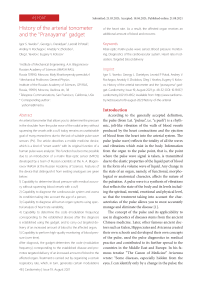History of the arterial tonometer and the “Pranayama” gadget
Автор: Igor S. Yavelov, Georgy L. Danielyan, Leonid P. Potak, Andrey V. Rochagov, Anatoly V. Zholobov, Oleg I. Yavelov, Eugeny V. Kolosov
Журнал: Cardiometry @cardiometry
Статья в выпуске: 19, 2021 года.
Бесплатный доступ
An arterial tonometer that allows you to determine the pressure in the shoulder from the pulse wave of the radial artery without squeezing the vessels with a cuff, today remains an unattainable goal of many researchers due to the lack of suitable pulse wave sensors (PV). The article describes a mobile medicine device, which is a kind of “smart watch” with its original function of a human pulse wave analyzer. This function has become possible due to an introduction of a matrix fiber-optic sensor (MFOS) developed by a team of Russian scientists at the A. A. Blagonravov IMASH at the Russian Academy of Sciences. Features of the device that distinguish it from existing analogues are given below: 1) Capability to determine blood pressure with medical accuracy without squeezing blood vessels with a cuff, 2) Capability to diagnose the cardiovascular system and assess its condition taking into account the age of a person, 3) Capability to diagnose all human organ systems using spectral analysis of heart rate variability, 4) Capability to determine the code (modulation frequency) corresponding to the established disease after the diagnosis is established using this gadget, and to carry out targeted delivery of an increased amount of blood to the affected organ, 5) Capability to perform high-quality monitoring of blood pressure (over time). After diagnosis, the gadget determines the code (modulation frequency) corresponding to the established disease and promotes targeted delivery of an increased amount of blood to the affected organ. Treatment is carried out by organizing a certain respiratory rate, which, in turn, generates certain modulations of the heart rate. As a result, the affected organ receives an additional amount of blood and recovers.
Fiber-optic matrix pulse wave sensor, Blood pressure monitoring, Diagnostics of the cardiovascular system, Heart rate modulation, Targeted blood delivery
Короткий адрес: https://sciup.org/148320550
IDR: 148320550 | DOI: 10.18137/cardiometry.2021.19.4852
Текст научной статьи History of the arterial tonometer and the “Pranayama” gadget
Igor S. Yavelov, Georgy L. Danielyan, Leonid P. Potak, Andrey V. Rochagov, Anatoly V. Zholobov, Oleg I. Yavelov, Eugeny V. Kolosov. History of the arterial tonometer and the “pranayama” gadget. Cardiometry; Issue 19; August 2021; p. 48-52; DOI: 10.18137/ cardiometry.2021.19.4852; Available from:
According to the generally accepted definition, the pulse (from Lat. “pulsus”, i.e. “a push”) is a rhythmic, jolt-like vibration of the walls of blood vessels produced by the heart contractions and the ejection of blood from the heart into the arterial system. The pulse (pulse wave) reflects the totality of all the waves and vibrations which exist in the body. Information from the organ to the pulse point, that is, the point where the pulse wave signal is taken, is transmitted due to the elastic properties of the liquid part of blood in the form of a volume wave of liquid. Any change in the state of an organ, namely, of functional, morphological or anatomical character, affects the nature of the pulsation. A pulse wave is a synthesis of vibrations that reflects the state of the body and its levels including the spiritual, mental, emotional and physical level, so that the treatment taking into account the characteristics of the pulse allows you to most accurately manage and eliminate the disease [1].
The concept of the pulse and its applicability to use in diagnostics of diseases stems from the ancient Chinese medicine. Later, other famous ancient doctors such as Galen, Hippocrates and Avicenna created their own schools and developed their own concepts of the pulse, used the pulse diagnostics in medical practice and contributed to its further spread to the countries in the Middle East and Europe. In his famous treatise “The Canon of Medicine” Avicenna wrote: “Some diseases, especially hidden from the eyes, I can identify only by a change in the pulse; the nature of the pulse is similar to that of music. According to a disorder in the harmony of the pulse, any hidden disease can be detected.” [1]. A historical and medical analysis of the “Canon” as a methodological approach and a comparison of its concepts with the ideas of modern propaedeutics of internal diseases were used.
The scientific basis of the concept of the pulse diagnostics was created after the discovery of blood circulation by V. Harvey in 1628, when his famous book “Exercitatio Anatomica de Motu Cordis et Sanguinis in Animalibus” was published. The invention of the sphygmograph and the implementation of pulse recording methods such as arteriopiezography, rheogra-phy, photoplethysmography, Doppler ultrasonography etc. brought the heart rate monitoring to a new level. Particularly, the computer mechanopulsography succeeded in deepening the knowledge in this research field [2, 3].
This relatively young scientific area allowed us to revise and supplement the ancient Tibetan pulse diagnostics at a new level and at the same time arrive at a modern interpretation of the physiological nature of the oriental “meridians” giving the proper scientific basis to many aspects of oriental medicine [4]. A special merit in the development of this field should be attributed to a research team at the IMASH RAS headed by Full RAS Member R. F. Ganiev [3-6], who designed and developed unique instrumentation for recording mechanopulsograms based on the application of fiber-optic sensors [5].
Research in this field has been conducting by IMASH RAS since 1989. As to international studies devoted to the topical issue in question, similar activities in this research area have been carried out since 1986 by the Australian company SphygmoCor (or AtCor-Medical). However, the technology offered by IMASH RAS should be considered to be more advanced, because only it allows you to overcome the problem of the proper sensor positioning.
The current level of research by the Russian scientists has made it possible to create a mobile medicine device based on fiber-optic sensors that has shown leading properties compared to products available on the world market, considering gadget lines Smart Watches and Trackers supplemented with medical functions.
Figure 1 shows the arterial tonometer developed by IMASH RAS.
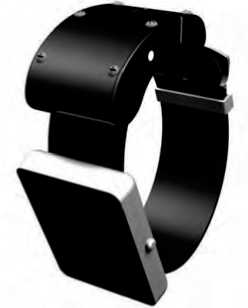
Figure 1. Arterial tonometer based on a matrix pulse wave analyzer
Our device belongs to the product line of mobile medical devices, or rather it can be classified to be a gadget found most closely to smart watches and trackers, embodying the achievements of information technologies. In order to successfully promote to the market, it has become a good tradition in the world practice to furnish devices of this sort with medical functions, for example: measuring pulse rate, computing the number of completed steps as well as various calculators of values related to the consumed food calories to control a diet. In addition, as a rule, according to manufacturer’s guide, most of these devices offer options for measuring blood pressure (BP), but even the most expensive smart watches do not meet the requirements of medical accuracy in measuring blood pressure today, so that they are only a toy that is confusing to users who often suffer from serious diseases. Modern classical cuff tonometers with appropriate fine-tuning can also be placed on the wrist, but basically they remain the mere automatic tonometers with all their typical shortcomings and can be of little use for high-quality blood pressure monitoring.
A radically new solution for monitoring blood pressure with medical accuracy is a non-cuff arterial tonometer, which does not require vascular compression. However, in the world practice, a sufficiently perfect device of this type has not yet been proposed due to the lack of high-quality pulse wave (PW) sensors. Another problem of the arterial tonometer design is the fact that the installation even of a high-quality PW sensor requires the proper accurate positioning of the latter to the top of the radial artery, which is usually achieved by relocating the sensor and searching for a high-quality signal. This procedure can be realized only if you have appropriate special qualifications, and therefore such devices are not designed for intuitive users that makes this sort of devices not marketable.
Thus, to overcome the disadvantages of the arterial tonometer, taking into account its obvious merits, it is necessary to solve the problems, i.e. to create high-resolution PW sensors and overcome the problem of positioning the sensor. It is these tasks that are being solved now by scientists from the Mechanical Engineering Research Institute at the Russian Academy of Sciences. A fiber-optic PW sensor has been created, which has unique properties and is capable to cope with the above obstacles. Figure 2 shows
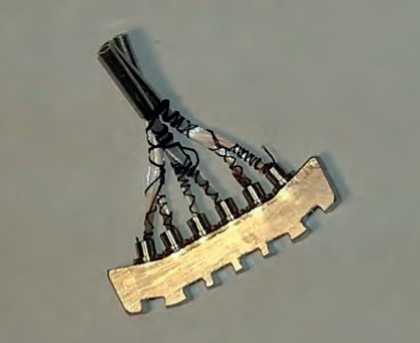
Figure 2. Fiber-optic element of a 3-point sensor the main sensor element developed by IMASH RAS jointly with GPI RAS (General Physics Institute at the Russian Academy of Sciences). This is a representative of modern high technologies, a fiber-optic collector demonstrating the high parametric reliability. It is an integral part of a cantilever matrix sensor with three working plates, due to which the positioning problem is solved.
As a result of the introduction of the matrix PW sensor, it became possible to develop high-resolution sphygmography, i.e., obtaining undistorted pulse waves by a non-invasive method. The long-term accumulation of the database made it possible to identify and classify the PW reference standard curve patterns related to age and functional changes in patients: they are given in Figure 3a herein. The respective age-related changes in PW are exhibited in Figure 3b herein.
Figure 3b shows the PW reference standard curve patterns corresponding to different ages with an interval of 10 years. It is of particular interest to determine the age of the measured PW with an accuracy of 1 year from these actual curve patterns. In this case, it becomes possible to make a diagnosis based on the functional state of the cardiovascular system in almost a few seconds, without visiting the doctor’s offices. Ap-

Figure 3. Digital contour pulse diagnostics: a) functional and age-related PW reference standard curve patterns in the form of a Greek-Latin square; age-related PW reference standard curve patterns as three-dimensional (b) and linear (c) versions.
parently, this is a very promising device for emergency health care and, of course, for general practitioners.
Another possibility is the diagnostics of the entire body, if with the help of the new device we begin to analyze heart rate variability (HRV). Moreover, it should be noted that in case of using pulse waves to assess HRV, the accuracy of the method increases by an order of magnitude. Therefore, the authors hereof developed a technique that allows not only to construct variability curves, but also to analyze them from the point of view of the presence of frequency modulations in HRV, which we attribute to the possibilities available to redistribute blood flow in the body. This allows freshly interpreting to certain extent the essence of acupuncture and may become the basis of autohemotherapy, a method of treatment using the redistribution of blood flows within the body. The technique has been described in detail earlier [4] and is illustrated by Figure 4 herein, since it reflects the con- ditional connections in the body in accordance with the generally accepted terminology of oriental medicine.
The components of diagnostics and treatment technology using software and hardware solutions developed by IMASH RAS are shown herein.
Statement on ethical issues
Research involving people and/or animals is in full compliance with current national and international ethical standards.
Conflict of interest
None declared.
Author contributions
Yavelov I. S., Danielyan G.L., Potak L. P. - writing the text, Rochagov A.V., Zholobov A.V. - collection and processing of materials, Yavelov O. I., Kolosov
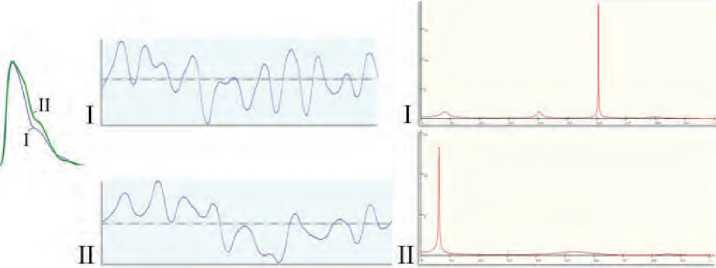
а)
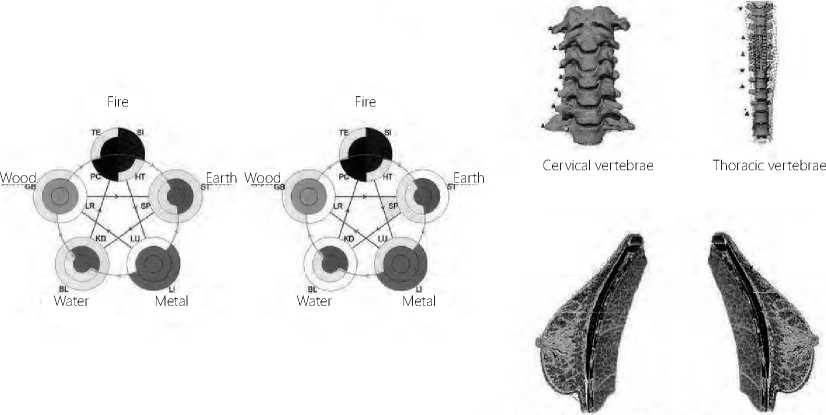
Longitudinal cross-section Longitudinal cross-section of left mammary gland of right mammary gland
b)
Figure 4. Components of targeted autohemotherapy: a) the envelope of heart rate variability and its spectrograms; b) pentagrams
and rains
-
E. V. - research concept and layout of the article. The authors read the ICMJE criteria for authorship and approved the final manuscript.
Список литературы History of the arterial tonometer and the “Pranayama” gadget
- Yavelov IS, Rochagov AV. Computer pulse diagnosis and analyzer “Pulse”. M. Izhevsk: Research Center “Regular and chaotic dynamics”, 2006. 160 p.
- Yavelov IS, Kaplunov SM, Danielyan GL. Fiber optic measuring systems. Applied problems // Ed. Doctor of Technical Sciences CM. Kaplunova. - M. - Izhevsk: Research Center “Regular and Chaotic Dynamics”, Institute of Computer Research, 2010.- 304s.
- Yavelov IS. The secret of the pulse wave. M. Izhevsk: Institute of Computer Research, 2012. 256 p.
- Yavelov IS, Dosko SI, Zholobov AV, Rochagov AV, Yavelov OI. On the nature of the eastern meridian. Russian Journal of Biomechanics. 2020; 24(2):243-7.
- Ganiev RF. Nonlinear wave mechanics, wave technologies and wave engineering. On Sat. Proceedings of the 6th International Scientific Conference “Fundamental Research and Innovative Technologies in Mechanical Engineering”. M .: IMASH RAS. 2019. 458p. (pp. 17-22).
- Yavelov IS. A method for measuring blood pressure and a device for its implementation. Pat. RF No. 2685470 dated 18.04. Dec 2019

